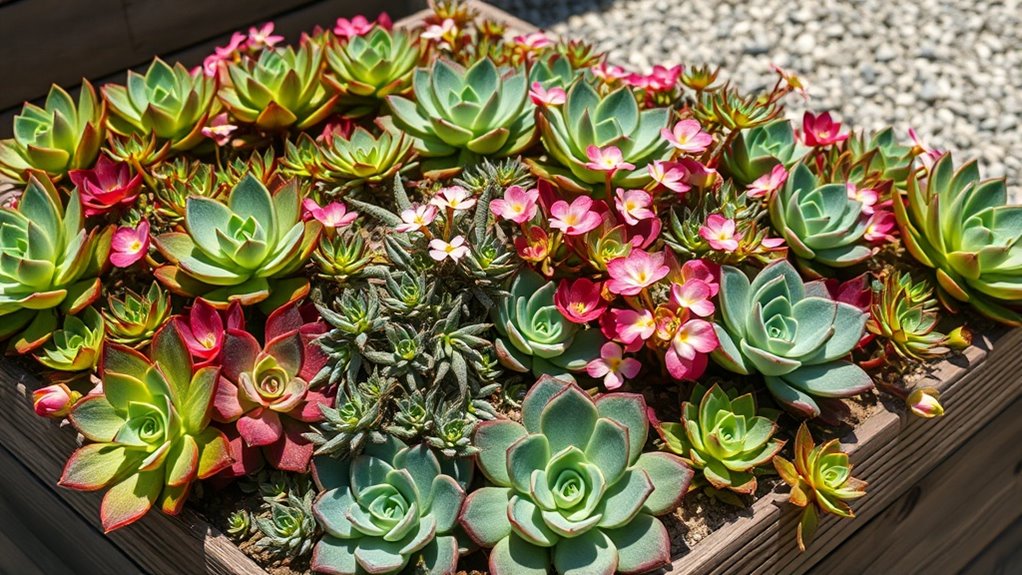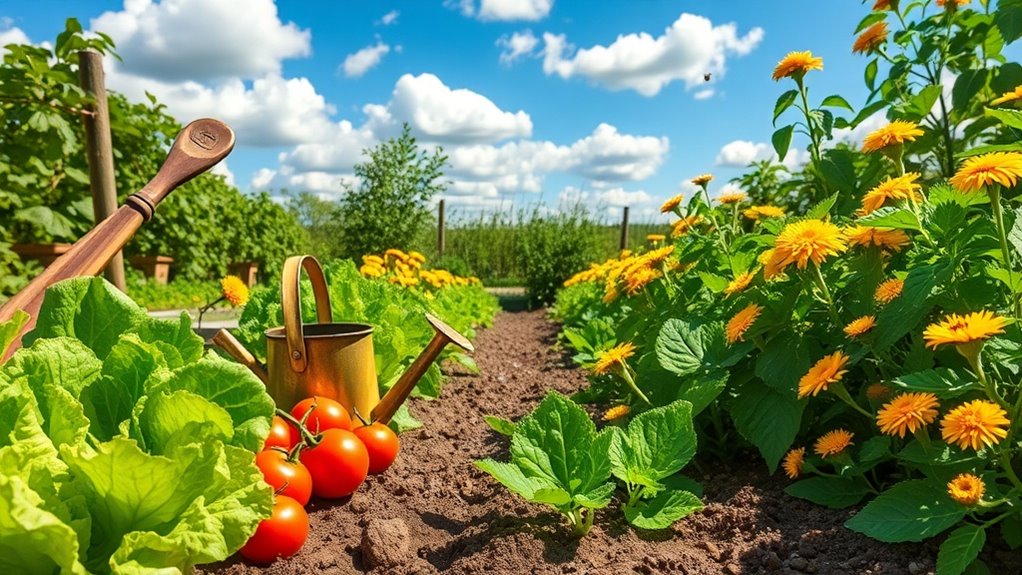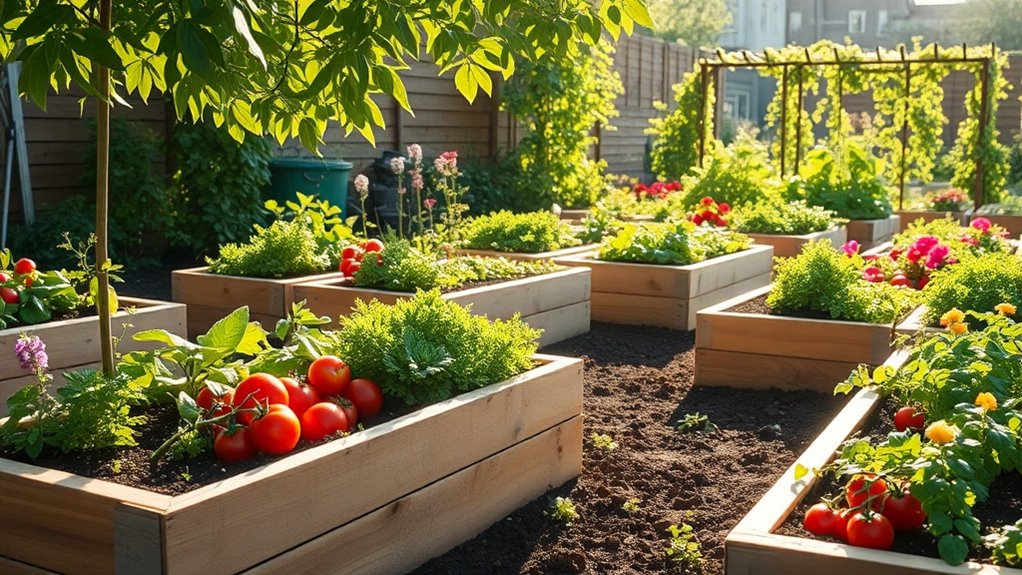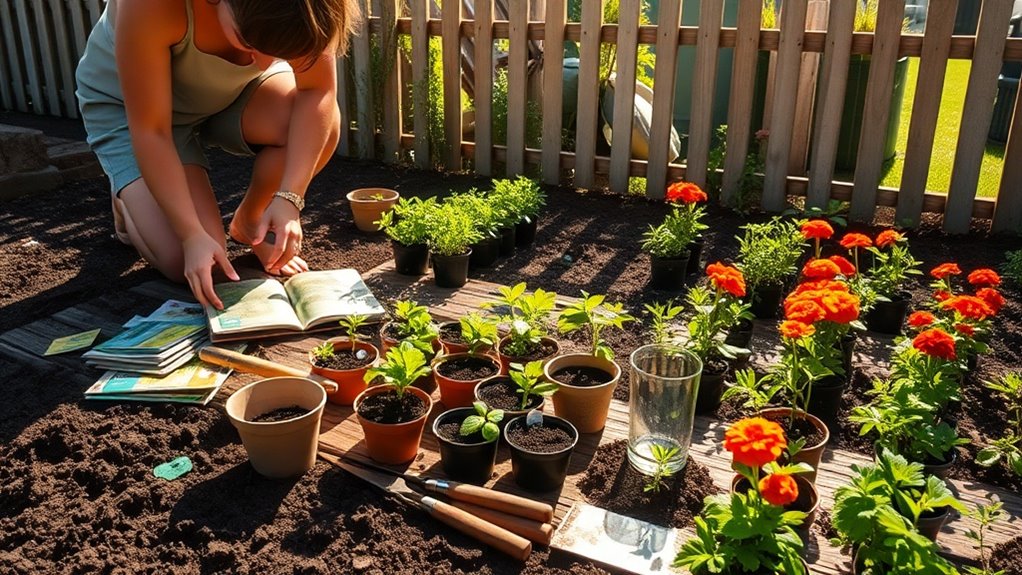I Only Water My Garden Once a Week – Here’s How It Still Thrives
You can make your garden thrive with just one weekly watering by using deep techniques that soak soil 6-8 inches deep, promoting strong roots and reducing evaporation. Choose drought-tolerant plants like succulents, lavender, and yarrow, then prepare your soil with compost for better moisture retention and regular pH testing. Water slowly in the early morning using a drip system and timer, while monitoring soil moisture to adjust for weather changes. By following these practical steps, you’ll avoid common pitfalls and keep your plants vibrant—uncover additional strategies for lasting success.
Key Takeaways
- Use deep watering techniques to soak soil 6-8 inches deep during weekly sessions.
- Choose drought-tolerant plants like succulents and native species for minimal water needs.
- Monitor soil moisture weekly with a finger test or meter to ensure adequate hydration.
- Apply 2-3 inches of mulch to retain moisture and reduce evaporation between waterings.
- Adjust watering based on weather, increasing in heat and skipping after rain.
The Deep Watering Technique Explained
When you adopt the deep watering technique, you’ll encourage your plants’ roots to grow deeper and stronger, fostering a more resilient garden.
This method involves soaking the soil thoroughly to penetrate at least 6-8 inches down, ensuring even moisture distribution.
You’ll apply water slowly using a hose or drip system, allowing it to infiltrate deeply without runoff. This technique aligns with effective watering timing strategies to maximize plant growth and minimize water usage.
Check soil moisture with your finger or a meter before watering; aim for once-weekly sessions that last 30-60 minutes per area.
By mastering this approach, you can achieve optimal growth for your garden plants.
Choosing Plants for Weekly Watering
Choosing the right plants for a weekly watering routine means focusing on species that thrive with deeper, less frequent hydration, as you’ve learned from the deep watering technique. Embracing effortless gardening can enhance your experience by introducing plants that require minimal upkeep and bring joy to novice gardeners.
You’ll want drought-tolerant options like succulents, lavender, and yarrow, which develop deep roots to access moisture efficiently.
Opt for natives adapted to your local climate; they require less water and resist pests better.
Always check plant tags for low-water indicators, and group similar needs together in your garden.
This approach ensures your selections flourish without constant attention, saving you time and effort while promoting sustainability.
Moreover, these plants align with low-effort plants that are perfect for beginners, offering easy care and rewarding results.
Soil Preparation Essentials
Before you start watering, you must choose the right soil type to support your plants’ water needs and root health.
Then, add organic matter like compost to improve soil structure and moisture retention, making your garden more efficient.
Finally, test your soil’s pH regularly to ensure it’s in the optimal range for the plants you’re growing.
Additionally, leverage backyard solutions such as leaves and grass clippings to naturally enhance soil fertility and promote sustainable gardening.
Implementing natural soil preparation can significantly boost your harvest, ensuring healthier plants and increased yield.
Choose Right Soil
To build a thriving garden, you’ll need soil that supports healthy roots and efficient water retention.
Select loamy soil for its balanced texture, offering excellent drainage without rapid drying. Test your soil’s composition using a simple kit to assess texture and pH—aim for a neutral range of 6.0 to 7.0, which optimizes nutrient availability and root growth.
Avoid overly sandy soils that drain too quickly or heavy clays that compact and hold excess water, risking rot.
Add Organic Matter
Once you’ve selected the right soil, you enrich it by mixing in organic matter, which boosts fertility and improves texture for better root growth.
Choose nutrient-rich options like compost, aged manure, or shredded leaves to enhance soil structure and microbial activity.
Spread a 2-4 inch layer evenly over your garden bed, then work it in deeply with a fork or tiller to promote aeration and moisture retention.
This practical step reduces watering frequency by improving the soil’s ability to hold water and nutrients, fostering resilient roots that support thriving plants.
Regularly incorporate organic matter each season to maintain long-term soil health and vitality.
Test Soil Ph
Testing your soil’s pH is a crucial step in soil preparation, as it reveals whether your garden bed is acidic, neutral, or alkaline, directly affecting nutrient availability for plants.
To test accurately, buy a reliable pH test kit or meter from a garden center; collect samples from several spots, mix with distilled water, and measure. Most vegetables and flowers thrive between 6.0 and 7.0.
If your soil’s too acidic, add lime; if alkaline, incorporate sulfur or peat. Adjust gradually to avoid shocking roots, ensuring optimal nutrient uptake so your plants stay hydrated longer with less frequent watering.
Step-by-Step Watering Methods
Effective watering starts with a few key steps that optimize your garden’s health and efficiency. In extreme heat, mulching around plants can help retain soil moisture and reduce evaporation losses.
First, check soil moisture by inserting your finger an inch deep; if it’s dry, it’s time to water.
Next, apply water slowly and deeply, ensuring it soaks the root zone for at least 6 inches to encourage strong growth.
Water in the early morning to minimize evaporation and allow absorption.
Direct the stream to the soil base, avoiding leaves to prevent diseases.
Finally, monitor plant responses weekly, adjusting based on weather to maintain that once-a-week thrive—your garden will thank you.
To enhance your watering routine, be mindful of common mistakes like overwatering, which can lead to root rot and hinder plant development.
Essential Tools for Deep Watering
To ensure your garden thrives, you’ll rely on soaker hoses to deliver water slowly and deeply to plant roots, promoting healthy growth without runoff. Budget-friendly tools can make these soaker hoses even more accessible for everyday gardeners.
These hoses let you water efficiently by placing them along your garden beds, soaking the soil evenly.
Meanwhile, drip systems enable you to target individual plants with precise, low-flow irrigation, conserving water while maintaining optimal moisture levels.
Incorporating these methods into your routine can help you achieve the benefits of DIY Watering Hacks, reducing the time spent on garden maintenance each week.
Soaker Hoses
Soaker hoses rank among the most reliable tools for deep watering your garden, delivering moisture directly to plant roots with minimal waste.
You’ll appreciate their porous design, which lets water seep slowly and evenly, promoting deeper root growth without surface runoff.
To use them effectively, lay the hose along your plant beds, cover with mulch for better retention, and connect to a timer for consistent weekly sessions.
This prevents evaporation and fungal issues, ensuring your plants thrive.
Regularly inspect for leaks or blockages to maintain efficiency, making your once-a-week routine simple and effective.
Drip Systems
Drip systems build on soaker hoses’ efficiency by targeting water directly at plant roots through a network of tubes and emitters.
You’ll conserve water by delivering it precisely where needed, reducing evaporation and runoff for deeper soil penetration. This method promotes healthier plants with less effort, ideal for your once-a-week routine.
-
Select emitters based on your plants’ needs, like drip rates for vegetables versus flowers.
-
Plan layout to cover all roots without overlapping, using a timer for automation.
-
Install securely to avoid leaks, burying tubes slightly for protection.
-
Maintain regularly by checking for clogs and flushing lines to ensure consistent flow.
-
Monitor soil to adjust watering, ensuring it stays moist without over-saturation.
Checking Soil Moisture Effectively
Knowing how to check your soil’s moisture is essential for a healthy garden, so you’ll want to start by feeling the soil directly with your finger—insert it about an inch deep to gauge if it’s damp or dry.
To enhance accuracy, use a moisture meter for deeper readings; it delivers precise data instantly. Check at consistent times, like early morning, to avoid misleading surface evaporation.
Pay attention to soil texture—crumbly means dry, sticky indicates moisture. This method helps you monitor effectively, ensuring your plants stay optimally hydrated without guesswork. Recognizing signs of overwatering early can prevent damage to your plants.
Additionally, by regularly assessing moisture levels, you can better decode soil signs that reveal the soil’s overall health and fertility for improved plant growth.
Common Challenges and Solutions
While maintaining optimal soil moisture in your garden, you’ll encounter common challenges like overwatering or underwatering that can harm your plants.
To keep your garden thriving, address these issues proactively with targeted solutions that build resilience.
-
Spot overwatering early: Check for soggy soil and yellow leaves; improve drainage by adding compost to prevent root rot.
-
Avoid underwatering: Test soil depth with your finger; apply deep, infrequent watering to encourage strong roots.
-
Handle inconsistent moisture: Use mulch to stabilize levels; it reduces evaporation and maintains even hydration.
-
Combat poor drainage: Mix in sand or perlite; this ensures water flows freely and prevents pooling.
-
Monitor plant signals: Observe wilting or growth stunts; adjust based on direct observations for optimal health.
Adjusting for Different Weather Conditions
As you maintain your garden, you’ll need to tweak your watering routine based on the weather to keep plants healthy and efficient.
In hot weather, increase your watering frequency to combat evaporation and support deeper root growth.
For rainy days and droughts, you’ll adjust by reducing water during downpours and implementing conservation strategies to preserve resources.
Hot Weather Tactics
In hot weather, you need to ramp up your watering strategy to combat rapid evaporation and keep plants hydrated. Focus on deep, infrequent sessions to encourage strong roots, using tools like a soaker hose for efficiency.
-
Water early or late: Schedule sessions at dawn or dusk to minimize evaporation and avoid leaf burn.
-
Increase volume slightly: Add 10-20% more water per session, checking soil depth for moisture.
-
Apply mulch layers: Use 2-3 inches of organic mulch around plants to retain soil moisture effectively.
-
Monitor plant signals: Watch for wilting or dry leaves and adjust based on specific plant needs.
-
Group thirsty plants: Cluster high-water plants together for targeted, efficient watering.
Rainy Day Adjustments
When rainy weather sets in, you’ll need to scale back your watering to prevent overhydration and potential root rot.
Install a rain gauge to track precipitation accurately; if it exceeds one inch weekly, skip your routine entirely.
Test soil moisture by inserting your finger an inch deep—if it feels damp, hold off watering.
Watch for early signs like yellowing leaves or fungal growth, indicating excess water.
Adjust based on soil type; clay retains moisture longer than sandy soil, so delay watering accordingly.
This practical strategy keeps your garden thriving without overwatering risks.
Drought Response Strategies
To combat drought conditions, you’ll need to adjust your watering practices smartly, focusing on efficiency and plant resilience. In dry weather, prioritize deep watering to encourage strong roots, while conserving resources and monitoring for stress signs like wilting.
-
Mulch effectively: Apply a thick layer around plants to retain soil moisture and suppress weeds, reducing evaporation by up to 70%.
-
Choose resilient varieties: Opt for drought-tolerant species like succulents or natives that thrive with minimal water, saving you effort.
-
Water deeply, infrequently: Soak the soil once a week to penetrate 6-8 inches, promoting deeper roots instead of shallow daily sprinkles.
-
Use efficient tools****: Switch to drip systems or soaker hoses to deliver water directly to roots, minimizing waste from runoff or evaporation.
-
Monitor soil moisture: Test the soil with a probe before watering; wait until the top few inches are dry to avoid overwatering and foster plant hardiness.
Real Examples of Thriving Gardens
While challenges like poor soil or pests can hinder growth, thriving gardens across various climates demonstrate the effectiveness of smart watering practices.
You witness this in California’s arid regions, where drought-resistant natives like lavender and succulents flourish from weekly deep soaks that encourage robust roots.
In Florida’s humid zones, you see citrus trees and vegetables thriving by timing water to avoid excess moisture, building natural resilience.
Even in England’s variable weather, your allotment garden of herbs and perennials stays vibrant with targeted weekly applications, proving these methods deliver consistent, healthy yields.
Ongoing Care and Tips for Success
Once you’ve established your watering routine, keep your garden thriving by monitoring soil moisture weekly and adjusting based on seasonal changes.
This prevents stress from droughts or excess rain, ensuring plants remain healthy and efficient. You’ll build resilience by focusing on soil health and plant signals.
-
Mulch effectively: Apply a 2-3 inch layer to retain moisture and suppress weeds.
-
Choose resilient plants: Opt for drought-tolerant varieties that suit your local climate.
-
Track weather patterns: Use apps or gauges to adjust watering before extremes hit.
-
Inspect regularly: Check leaves and soil for pests or nutrient issues to act quickly.
-
Deep water wisely: Soak roots thoroughly during your weekly session for deeper growth.





